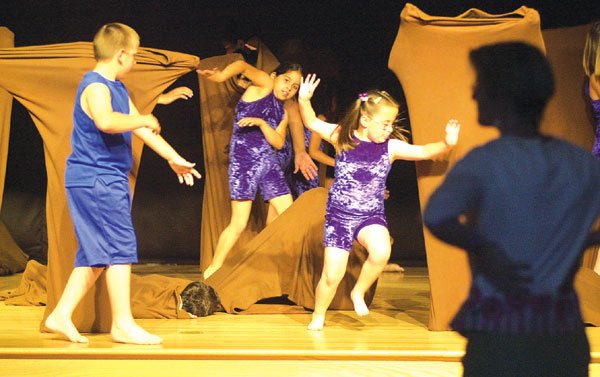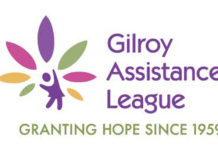Bianca Gamez has danced, sung and acted her way to the fifth
grade. Since she was in kindergarten, the 11-year-old aspiring
dance teacher has immersed herself in theater productions at
Gilroy’s Antonio Del Buono Elementary School, mostly because it
gives her a chance to be around her friends in a fun, upbeat
setting while learning new rhythms and moves.
Bianca Gamez has danced, sung and acted her way to the fifth grade. Since she was in kindergarten, the 11-year-old aspiring dance teacher has immersed herself in theater productions at Gilroy’s Antonio Del Buono Elementary School, mostly because it gives her a chance to be around her friends in a fun, upbeat setting while learning new rhythms and moves.
Bianca knows how much she loves to perform. What she likely doesn’t know is the impact tightening budgets have had on music and the arts in local public schools. Even though dollars are dwindling, schools are managing to keep the arts alive – largely thanks to parent support.
Before school lets out for the summer, Bianca and the rest of the cast at Del Buono will present “Under the Kapok Tree,” a tale exploring the customs of the Beng people of Ivory Coast in western Africa. The production is the culmination of Del Buono’s after-school performance group, which has kept afloat for a number of years with the help of parent volunteers.
“Every one of these children has the potential to become something great, and the arts gives them the opportunity to excel,” said Angelica Wong, a mother of two students at Del Buono who has volunteered for the group for four years. “They learn so many things here – creative movement, discipline, teamwork.”
Parent support for the arts in schools includes donations of both time and money. The Gilroy High School Band’s Booster Club – consisting primarily of parents – raised $7,200 this year to purchase instruments and music for the program.
The Gilroy Unified School District’s total budget for art and music this year was about $468,000 – up from last year’s $462,000, but down from nearly $520,000 in 2002-03, said Steve Brinkman, the district’s superintendent of administrative services.
With about 9,850 students total, Gilroy’s district is significantly larger than both the Morgan Hill Unified School District and the Hollister School District.
In Morgan Hill’s roughly 8,500-student district, the annual budget for art and music for grades 4 to 6 has dwindled from roughly $260,000 to $140,000, with budgets for the remaining grades varying from school to school, said Linda Mann, the district’s director of curriculum.
Hollister’s district, with about 6,160 students, has an annual budget for art and music of about $140,000.
The amount has remained relatively stable over the past four years but it has barely been enough for the district to scrape by, said Anita Franchi, director of educational services.
“We have really had to re-prioritize, and unfortunately, arts and music were last on the priority list,” Franchi said. “We’re getting by this year because of parent support, because they were able to keep it as a priority.”
A major reason art and music have taken a backseat in schools is because the state’s department of education has placed increasing emphasis on the core curriculum subjects of reading and math.
Even social studies and science lessons have been cut or reduced from many classrooms as teachers scramble to squeeze into their days what the state requires.
At the elementary level, for example, in order for schools to fulfill the standards required by California, the state recommends devoting 2 1/2 hours a day to language arts, an hour a day to math and 100 minutes a week to physical education.
After allocating time for recesses and lunch, not a whole lot is left over for the arts. Intervention students who need additional help with lessons get first priority during after-school hours, making after-school performance groups such as Del Buono’s a bonus.
Because of the time shortage, core-curriculum teachers have to find ways to try to meld musical and artistic activities with other subjects, such as putting a tune to a poem or drawing a character from a book.
Additionally, music teachers must maximize their time with students and plan their lessons efficiently, which isn’t always easy: In Hollister’s district, for example, one music teacher is stretched over six elementary schools – teaching 400 kids – while a second music teacher is split between the district’s two middle schools.
“Teachers have had to do a lot to be creative and fit it all into their days,” Franchi said. “But I’m a strong believer in multiple intelligences. I think a lot of children can only be reached through music and the arts. If you eliminate those, that means you’re not reaching the whole child.”
Indeed, extensive research over the past decade has proven the link between children who study music and advanced patterns of brain development.
Many studies have shown that children who learn to play an instrument or get involved in visual arts score higher on standardized tests and show increased comprehension of literature, math and science.
A recent report from the National Association for Music, for instance, compared 237 second-graders learning new math skills using a math software program.
The first group used only the software, while the second group combined the software with piano keyboard training. According to the study, the second group scored 27 percent higher on proportional math and fractions tests than the children who used just the software.
The connection between music and intellectual development continues in children as they get older. Studies by the College Entrance Examination Board showed students with coursework or experience in music performance and music appreciation scored an average of 57 points higher on the verbal portion of the SAT and 41 points higher on the math portion.
That local schools see value in the arts is evident in their extracurricular programs. In Morgan Hill, for instance, Live Oak High School’s Emerald Regime Marching Band and Color Guard travel the region throughout the year to perform and compete.
GHS has numerous bands, including a wind ensemble and jazz, symphonic and winter percussion bands. The accomplished GHS Chamber Singers, a 32-member, audition-only choir, performs and competes throughout the area and travels overseas every year.
Hollister’s Rancho San Justo Concert Band, which includes students from Maguerite Maze Middle School, competes across the Bay Area and also participates in local parades and concerts.
In March, the band – along with San Benito High School’s band – won first place in the School of Rock contest, put on by KFOX 98.5, a San Jose classic rock station. The Hollister students beat out more than a dozen other Bay Area schools.
Well-established extracurricular programs also are part of daily life at local elementary schools. Del Buono, for example, is home to the Suzuki Violin Program, a violin-performance group with about 50 students. Directed by violin instructor Lori Franke, the program was established six years ago and relies “99 percent on parent support,” said Del Buono principal Tammy Gabel.
“This year, we’re getting by on a prayer. But our parents have been so, so supportive,” Gabel said. “They really are the heart and soul of this program.”
The group has managed most of the cuts by reducing the number of group and private lessons, leaving the students with less one-on-one time with Franke.
“Somehow (art and music is) always the first thing to go, the first to get cut,” Franke said. “It seems like it’s gone from bad to worse. But I think if people could understand the importance of music in education, they’d see how necessary it really is.”
And it’s hard not to appreciate the importance of music in education when observing a gymnasium full of elementary school students, hopping around in blue velvet jumpsuits imitating frogs.
Such was the scene at a recent rehearsal for Del Buono’s “Under the Kapok Tree,” with a breathless but smiling Bianca taking a well-deserved breather.














